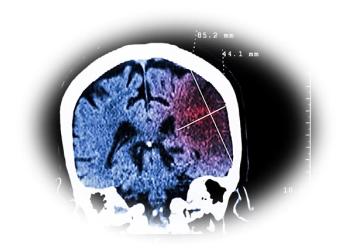
Young Man With Loud,Asymptomatic Heart Murmur
A 27-year-old man is referred by an occupational health clinic for evaluation ofa heart murmur. The murmur was detected during a company-mandated examinationfor a flu-like illness that had caused him to miss several days of work.Before the onset of this illness, he had felt well and had no unusual complaints.He denies symptoms of congestive heart failure.
A 27-year-old man is referred by an occupational health clinic for evaluation ofa heart murmur. The murmur was detected during a company-mandated examinationfor a flu-like illness that had caused him to miss several days of work.Before the onset of this illness, he had felt well and had no unusual complaints.He denies symptoms of congestive heart failure.HISTORYThe patient's job and recreational activities both involve much strenuouseffort; however, these have never caused him difficulty or resulted in symptoms.When he was in grade school, he was told he had a heart murmur, buthe was never medically evaluated or followed for it. He takes no long-termmedications. He does not smoke or use illicit drugs, but he does consume alcoholin moderation.PHYSICAL EXAMINATIONAND IMAGING RESULTSBlood pressure is 115/75 mm Hg; jugular venous and carotid arterypulses are normal. Chest examination reveals no rales or consolidations. Theapical impulse is not laterally displaced, but a left parasternal thrill is palpable.S1 is normal and S2 is physiologically split. A harsh grade 4/6 holosystolicmurmur is audible; it is loudest at the left parasternal border in the third intercostalspace and radiates to the right. There is no cyanosis, clubbing, or edema.Chest radiograph and ECG are normal. An echocardiogram is ordered.Based on the presumptive diagnosis, which of the following is true?A. Valve replacement will be required when the mean aortic valve gradientexceeds 50 mm Hg.B. If surgical repair is not performed, fatal right ventricular failure can beexpected to occur in 3 to 5 years.C. Infective endocarditis poses the greatest risk to this patient; consequently,antibiotic prophylaxis is required.D. The patient's low oxygen saturation is causing secondary polycythemiathat requires phlebotomy.CORRECT ANSWER: C
The clinical findings here--in particular, the loudness of themurmur and its location at the lower left sternal borderwithout radiation to the neck--make a small ventricular septaldefect (VSD) the most likely diagnosis. Aortic stenosiscan also result in a loud murmur that is most notable at thecardiac base. However, aortic stenosis is usually associatedwith a murmur that radiates into the neck (carotid arteries)and possibly a delayed aortic upstroke and diminished secondheart sound, none of which are evident here. Thus,choice A, an indicationfor surgeryin patients withaortic stenosis, isincorrect.This patienthas no clinicalfindings that suggesta reversalof flow from rightto left. This reversaloccursin patients withlarger VSDs,which over timecause high pulmonaryvascularresistance, pulmonaryhypertension,andright-to-left flow.In such patients,the pressure inthe right ventricle approaches that in the left, which resultsin diminished flow across the defect and reduced intensityof the murmur. Affected patients typically exhibita right ventricular heave, cyanosis, and clubbing. Noneof these findings are present here; in fact, reversal of flowis uncommon with small VSDs. Thus, choice D, which describesa complication of reversed flow (hypoxemia withsecondary polycythemia), is unlikely.Both the natural history of a VSD and decisions regardingits surgical repair are contingent on the size ofthe defect and its effect on pulmonary vascular resistance.Small defects are well tolerated; they allow pulmonarypressures to be maintained at normal levels, produce nosymptoms, and pose only a very small risk of right ventricularfailure. For large VSDs, however, surgical closureis recommended before problems arise that can causemorbidity and early mortality. Thus, choice B is incorrect;this patient's VSD is most likely small and consequentlydoes not require surgical closure.This patient is at significant risk for infective endocarditis,however, and he should receive appropriate antibioticprophylaxis. Thus, choice C is correct.Outcome of this case. An echocardiogram confirmeda small VSD at the membranous level with left-torightflow (Qp/Qs = 1.1/1.0). Systolic function in both theleft and right ventricles was normal, as was the left ventricularejection fraction. The patient was advised of theneed for and logistics of endocarditis antibiotic prophylaxis.He will be followed by a cardiologist.
References:
FOR MORE INFORMATION:
- Brickner ME, Hillis D, Lange RA. Congenital heart disease in adults-first oftwo parts (acyanotic conditions). N Engl J Med. 2000;342:256-263.
- Brickner ME, Hillis D, Lange RA. Congenital heart disease in adults-secondof two parts (cyanotic conditions). N Engl J Med. 2000;342:334-342.
- Kidd L, Driscoll DJ, Gersony WM, et al. Second natural history study of congenitalheart defects: results of treatment of patients with ventricular septal defects.Circulation. 1993;87(suppl 1):1-338.
Newsletter
Enhance your clinical practice with the Patient Care newsletter, offering the latest evidence-based guidelines, diagnostic insights, and treatment strategies for primary care physicians.



























































































































































































































































































































